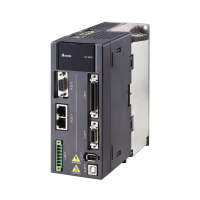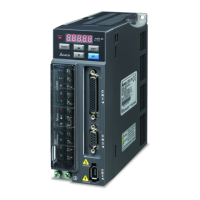Chapter 6 Applied Instructions
6-451
API Instruction code Operand
Function
2104 D HABIN P
S, D
Converting the hexadecimal ASCII code
into the hexadecimal binary number
Device
X Y M S T C HC D L SM SR E PR K 16# “$” DF
Pulse instruction
16-bit instruction (5-11 steps) 32-bit instruction (5-11 steps)
Symbol:
S
Source value Word
D
Device in which the conversion
result is stored
Word/Double word
Explanation:
1. The hexadecimal ASCII code in S is converted into the hexadecimal binary number, and the
conversion result is stored in D.
2. The operand S used in the 16-bit instruction occupies two word devices, and the hexadecimal
ASCII code in S should be within the range between 0000 and FFFF. If S is a string, the string
should be within the range between “0” and “FFFF”.
b15
b0
b7 b8
S
S
+1
b15
b0
D
16-bit binary number
First ASCII code
Second ASCII code
Third ASCII code
Fourth ASCII code
If the ASCII code in S~S+1 is 5A8D, the conversion result is as follows.
b15
b0
b7 b8
S
S
+1
b15
b0
D
16#41(A)
35(5)16#
16#44(D) 38(8)16#
5A8D16#
3. The operand S used in the 32-bit instruction occupies four word devices, and the hexadecimal
ASCII code in S should be within the range between 00000000 and FFFFFFFF. If S is a string,
the string should be within the range between “0” and “FFFFFFFF”.
b15
b0
b7 b8
S
S
+1
S
S
+3
+2
D +1
D
First ASCII code
Second ASCII code
T
hird ASCII code
Fourth ASCII code
Fifth ASCII code
Sixth ASCII code
Seventh ASCII code
Eighth ASCII code
32-bit binary number
If the ASCII code in S~S+3 is 5CB807E1, the conversion result is as follows.
b15
b0
b7 b8
S
S
+1
16#43(C)
35(5) 16#
38(8) 16# 42(B) 16#
16# 5CB8
16#37(7)
30(0) 16#
16#31(1) 16#45(E)
S
+2
S
+3
16# 07E1
D+1
D D

